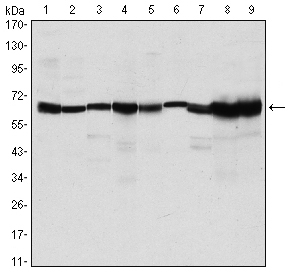PRMT4 Monoclonal Antibody
- Catalog No.:YM0535
- Applications:WB;IHC;IF;FCM;ELISA
- Reactivity:Human;Rat;Monkey
- Target:
- CARM1
- Fields:
- >>Endocrine resistance
- Gene Name:
- CARM1
- Protein Name:
- Histone-arginine methyltransferase CARM1
- Human Gene Id:
- 10498
- Human Swiss Prot No:
- Q86X55
- Mouse Swiss Prot No:
- Q9WVG6
- Rat Gene Id:
- 363026
- Rat Swiss Prot No:
- Q4AE70
- Immunogen:
- Purified recombinant fragment of human PRMT4 expressed in E. Coli.
- Specificity:
- PRMT4 Monoclonal Antibody detects endogenous levels of PRMT4 protein.
- Formulation:
- Liquid in PBS containing 50% glycerol, 0.5% BSA and 0.02% sodium azide.
- Source:
- Monoclonal, Mouse
- Dilution:
- WB 1:500 - 1:2000. IHC 1:200 - 1:1000. IF 1:200 - 1:1000. Flow cytometry: 1:200 - 1:400. ELISA: 1:10000. Not yet tested in other applications.
- Purification:
- Affinity purification
- Storage Stability:
- -15°C to -25°C/1 year(Do not lower than -25°C)
- Other Name:
- CARM1;PRMT4;Histone-arginine methyltransferase CARM1;Coactivator-associated arginine methyltransferase 1;Protein arginine N-methyltransferase 4
- Molecular Weight(Da):
- 66kD
- References:
- 1. FASEB J. 2008 Sep;22(9):3337-47.
2. Nucleic Acids Res. 2008 Jun;36(10):3202-13.
- Background:
- This gene belongs to the protein arginine methyltransferase (PRMT) family. The encoded enzyme catalyzes the methylation of guanidino nitrogens of arginyl residues of proteins. The enzyme acts specifically on histones and other chromatin-associated proteins and is involved in regulation of gene expression. The enzyme may act in association with other proteins or within multi-protein complexes and may play a role in cell type-specific functions and cell lineage specification. A related pseudogene is located on chromosome 9. [provided by RefSeq, Aug 2013],
- Function:
- catalytic activity:S-adenosyl-L-methionine + histone-arginine = S-adenosyl-L-homocysteine + histone-N(omega)-methyl-arginine.,function:Methylates (mono- and asymmetric dimethylation) the guanidino nitrogens of arginyl residues in several proteins involved in DNA packaging, transcription regulation, and mRNA stability. Recruited to promoters upon gene activation together with histone acetyltransferases from EP300/P300 and p160 families, methylates histone H3 at 'Arg-17' and activates transcription via chromatin remodeling. During nuclear hormone receptor activation and TCF7L2/TCF4 activation, acts synergically with EP300/P300 and either one of the p160 histone acetyltransferases NCOA1/SRC1, NCOA2/GRIP1 and NCOA3/ACTR or CTNNB1/beta-catenin to activate transcription. During myogenic transcriptional activation, acts together with NCOA3/ACTR as a coactivator for MEF2C. During monocyte inflam
- Subcellular Location:
- Nucleus . Cytoplasm . Mainly nuclear during the G1, S and G2 phases of the cell cycle (PubMed:19843527). Cytoplasmic during mitosis, after breakup of the nuclear membrane (PubMed:19843527). .
- Expression:
- Overexpressed in prostate adenocarcinomas and high-grade prostatic intraepithelial neoplasia.
- June 19-2018
- WESTERN IMMUNOBLOTTING PROTOCOL
- June 19-2018
- IMMUNOHISTOCHEMISTRY-PARAFFIN PROTOCOL
- June 19-2018
- IMMUNOFLUORESCENCE PROTOCOL
- September 08-2020
- FLOW-CYTOMEYRT-PROTOCOL
- May 20-2022
- Cell-Based ELISA│解您多样本WB检测之困扰
- July 13-2018
- CELL-BASED-ELISA-PROTOCOL-FOR-ACETYL-PROTEIN
- July 13-2018
- CELL-BASED-ELISA-PROTOCOL-FOR-PHOSPHO-PROTEIN
- July 13-2018
- Antibody-FAQs
- Products Images

- Western Blot analysis using PRMT4 Monoclonal Antibody against MCF-7 (1), HeLa (2), NIH/3T3 (3), HL-60 (4), LNcap (5), Jurkat (6), PC-3 (7), Cos7 (8), and PC-12 (9) cell lysate.

- Immunohistochemistry analysis of paraffin-embedded breast cancer tissues (left) and ovarian cancer tissues (right) with DAB staining using PRMT4 Monoclonal Antibody.

- Immunofluorescence analysis of Hela cells using PRMT4 Monoclonal Antibody (green). Red: Actin filaments have been labeled with Alexa Fluor-555 phalloidin.

- Flow cytometric analysis of Lovo cells using PRMT4 Monoclonal Antibody (green) and negative control (purple).


